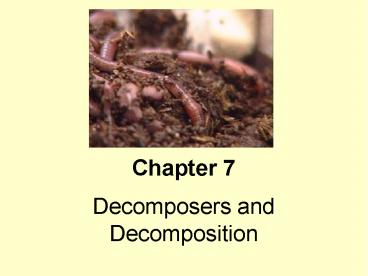Decomposers and Decomposition - PowerPoint PPT Presentation
Title:
Decomposers and Decomposition
Description:
Chapter 7 Decomposers and Decomposition Decomposition? Decomposition Decomposition breakdown of chemical bonds formed during the construction of plant and animal ... – PowerPoint PPT presentation
Number of Views:396
Avg rating:3.0/5.0
Title: Decomposers and Decomposition
1
Chapter 7
- Decomposers and Decomposition
2
Decomposition?
3
Decomposition
- Decompositionbreakdown of chemical bonds formed
during the construction of plant and animal
tissue. - Organisms that feed on dead organic matter or
detritus - Microbial decomposersbacteria and fungi
- Detritivoresanimals that feed on dead material
4
Carbon
- Carbon sequestration
- CO2 vs. organic matter
- Forests vs. barren land
- Atmosphere vs. biomass
5
Stages of decomposition
- Leachingloss of soluble sugars/dissolved
compounds - Fragmentationreduction into smaller
particles physical/chemical fragmentation
6
Energy processing
- Energy and nutrients from organic compounds
- oxidation of carbohydratesrespiration
- Mineralizationorganic ? inorganic
- Immobilizationinorganic ? organic
7
Decomposers
- Groups based on size
- Microfloramost common decomposers
- bacteriaanimal material
- fungiplant material
- Aerobicrespiration
- Anaerobicfacultative/obligate anaerobes
- Fermentationsugars? organic acids/alcohol
8
Decomposers
- Microfauna/microflora lt1 mm ? 100 mm
- Mesofauna 100 mm ? 2mm
- Macrofauna 2mm ? 20 mm
- Megafauna 20 mm ? 64 mm
- Microbivores feed on bacteria and fungi
9
Food Quality
- Energy and nutrient source
- Litterdead plant material
- Quality related to chemical bonds/structure
- simple sugars vs. complex carbohydrates
- Lignincomplex class of carbohydrates
- little net gain of energy for decomposers
10
Rate of decomposition
- Inverse relationship between rate and lignin
content - Quality influences feeding of large detritivores
11
Aquatic environments
- Phytoplanktonlow lignin content
- Vascular plantshigh lignin content
- O2 dependent
- Low O2 absence of fungi
12
Animal matter
- Chemical breakdown easier than plants
- Flesh consumed by scavengers
- 70 decomposed by bacteria and arthropods
(maggots) - Temperature dependent
13
Fecal matter
- Mostly decomposed
- Herbivorespartially digested organic matter
- Specialized detririvores larvae incubate and
feed - Tumblebugsincubate larvae
14
Physical influence
- Temperature and moisture
- Influence rate of decomposition
- Decomposition highest in warm/wet climates
- Temperature parallels CO2 release
15
Nutrients
- Nitrogen ? nutrient value
- Organisms require N for growth during
mineralization - Mineralization and immobilization taking place
simultaneously - Net mineralization rate
16
Stages of nutrient concentration
- Water soluble compounds leached
- Dependent upon soil moisture
- N increasesimmobilization from other sources
- As C quality declinesnet release of N
- Dependent upon original nutrient content
17
Aquatic decomposition
- Similar to terrestrial ecosystems
- Influenced by abundance of water
- More stable environment favors decomposition
- More accessibility to detritivores
18
Aquatic systems
- Particulate organic matter (POM)
- Coarse particulate organic matter (CPOM)
- Fine particulate organic matter (FPOM)
- Water depth determines organic makeup
- Benthic organic matter bacteria
- Aerobic vs. anaerobic
- Dissolved organic matter (DOM)
19
Aquatic sources
- DOM readily available
- Sourcesalgae, zooplankton
- Death of phyto/zooplankton
- Bacteria concentrate DOM
- Mineralization and immobilization of nutrients
- Excretion of exudates and feces
20
Organic matter processing
- Physical mechanism
- Water soaked leaves sink
- 5 30 organic matter leached
- Biological mechanism
- Covered withbacteria fungi
- CPOM FPOM
- Degrade celluloseand metabolize lignin
21
Flowing water
- Shredders attack CPOM
- Feed also on attached microbes
- Becomes FPOM
- Filterers / collectors gather FPOM
- Feed also on attached microbes
- Grazers feed on algal coatings
- leftovers enter stream as FPOM
- Gougers feed on woody debris
- Predators feed on all the above
22
- Nutrient passes from water column? plants ?
consumer ? another consumer ? poop nutrient
cycling - Downstream flow new dimension
- Physical retention
- Storage in wood detritus
- Leaf sediments
- Beds of macrophytes
- Biological retention
- Uptake and storage in plant/animal tissue
23
Recycling, retention downstream displacement
- Downstream transport nutrient cycling
nutrient spiraling - One cycle
- Uptake of an atom from DOM
- Passage through food chain
- Return to water for reuse
- Spiraling distance of one cycle
- shorter cycle tighter spiral
- longer cycle more open spiral
24
River Continuum Concept
- From headwaters to mouth ? continuum of
changes in conditions - Headwater streams (1-3)
- Swift, cold, forested
- Strongly heterotrophic
- Dominant organisms
- Shredders CPOM
- Collectors FPOM
25
- Midorder streams (4-6)
- Riparian vegetation important
- Canopy opens ? primary production
- Temperature increases / current slows
- Primary production gt community respiration
- Dominant organisms
- Collectors FPOM
- Grazers algae macrophytes
26
- Higher order streams (6 10)
- Channel wider deeper
- Volume of flow increases
- Autotrophic production decreases
- Shift back to heterotrophy
- Energy from FPOM
- Utilized by bottom dwellers
- Phytoplankton zooplankton population minimal































